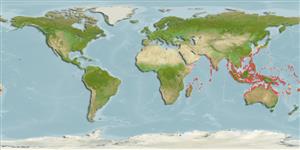Gastropoda |
Neogastropoda |
Muricidae
Environment: milieu / climate zone / depth range / distribution range
Ecology
Benthic; depth range 1 - 15 m (Ref. 349). Tropical
Indo-West Pacific: in southeast Africa and Madagascar, and from the easternmost part of the Indian Ocean to Melanesia; north to southern Japan and south to northern Queensland and New Caledonia; probably in the Marshall Islands.
Length at first maturity / Size / Weight / Age
Maturity: Lm ? range ? - ? cm Max length : 10.5 cm SHL male/unsexed; (Ref. 349); common length : 8.0 cm SHL male/unsexed; (Ref. 349)
Used as food locally, the empty shell sold for collections (Ref. 349). Mainly found in shallow water (Ref. 349).
Life cycle and mating behavior
Maturity | Reproduction | Spawning | Eggs | Fecundity | Larvae
This species is a non-broadcast spawner. Life cycle does not include trocophore stage. Also Ref. 833.
Poutiers, J.M. 1998 Gastropods. p. 363-648. In Carpenter, K. E. and V. H. Niem. 1998. FAO species identification guide for fishery purposes. The living marine resources of the Western Central Pacific. Volume 1. Seaweeds, corals, bivalves, and gastropods. Rome, FAO. (Ref. 349)
IUCN Red List Status
(Ref. 130435: Version 2025-1)
CITES status (Ref. 108899)
Not Evaluated
Not Evaluated
Threat to humans
Harmless
Human uses
Fisheries: commercial
| FishSource |
Tools
More information
Trophic EcologyFood items (preys)
Diet composition
Food consumption
Predators
Population dynamicsGrowth
Max. ages / sizes
Length-weight rel.
Length-length rel.
Length-frequencies
Mass conversion
Abundance
Life cycleReproductionMaturityFecunditySpawningEggsEgg developmentLarvae PhysiologyOxygen consumption
Human RelatedStamps, coins, misc.
Internet sources
Estimates based on models
Preferred temperature
(Ref.
115969): 24.7 - 29.3, mean 28.5 (based on 2962 cells).
Fishing Vulnerability
Low vulnerability (10 of 100).
